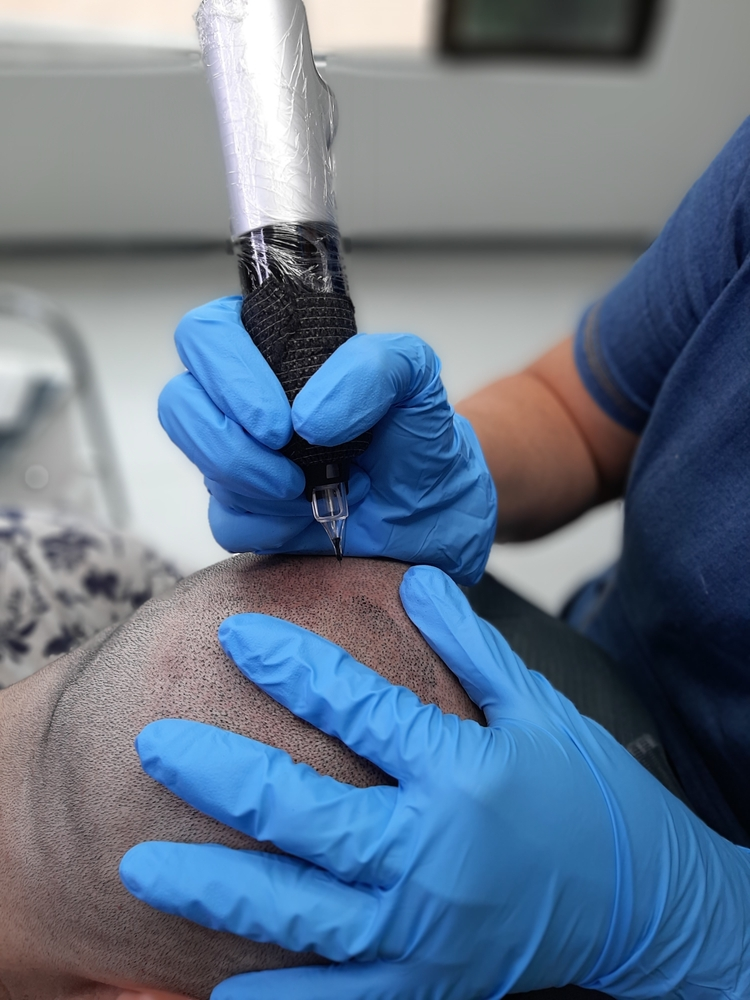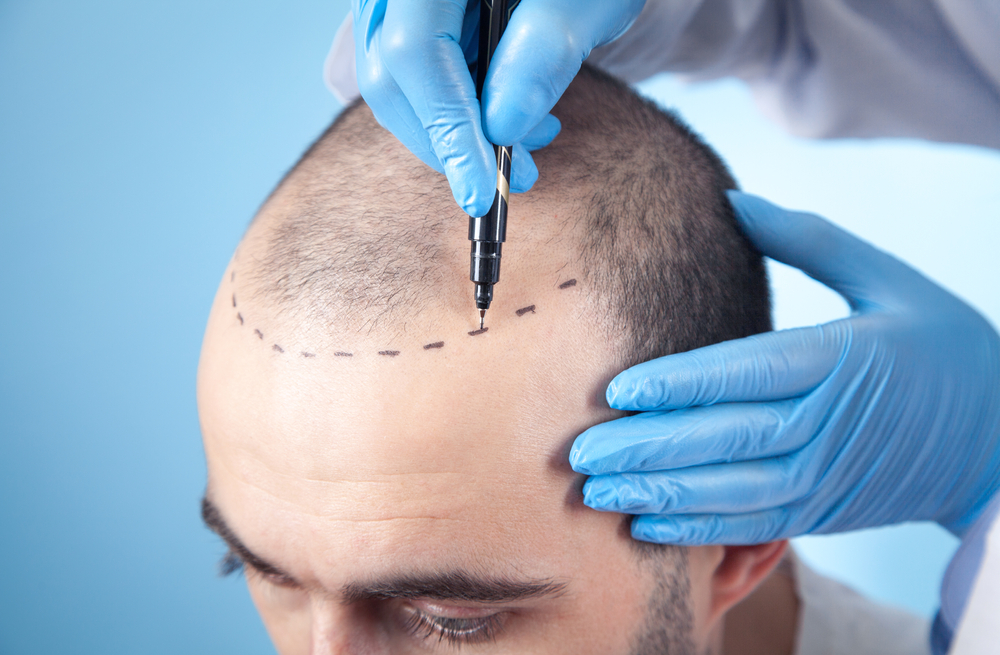What are hair tattoos for hair loss?
While any ink on the scalp is technically a “hair tattoo”, we’re specifically talking about the treatment for hair loss. In this context, it’s technically called scalp micropigmentation (or SMP) and is a relatively new treatment for hair loss.
Scalp micropigmentation is a cosmetic medical procedure- so picture a sterile clinic, rather than a shady tattoo parlour. The procedure is performed by a trained professional who uses a tiny, thin needle to deposit pigment dots over the scalp, mimicking the appearance of natural hair follicles.

Scalp micropigmentation can produce quite a natural-looking result- sort of like a close fade or buzz cut- and creates the appearance of a thicker head of hair, better hair density and wider coverage over the scalp. While it’s used to treat a variety of conditions, hair tattoo treatment is a relatively new treatment option so there are some things to be aware of.
Who can benefit from hair tattooing?
Hair tattoo procedures are used mainly to improve hair loss from male pattern baldness, by creating the appearance of a full head of hair. Scalp tattoos can also be used to:
- Target specific bald spots
- Combat the appearance of extensive hair loss
- Create a thicker appearance to treat thinning hair
- Reverse a receding hairline (through a hairline tattoo)
- Cover up hair and scalp deformities, like scars from alopecia or hair transplant surgery
Scalp micropigmentation can produce potentially life-changing results for hair loss sufferers, with natural-looking hair coverage that restores confidence and self-esteem. But just like traditional tattoos, you’ll need to prepare and understand the risks involved.
How does the scalp micropigmentation procedure work?
Before the hair tattoo procedure
Before you start, it’s worth discussing your options with a specialist. They’ll be able to answer your questions (if our FAQ section doesn’t first!) and create a plan based on your specific pattern of hair loss and desired coverage.
- Ahead of your first appointment, you’ll need to wash your hair and scalp.
- The practitioner will then mark the scalp areas for treatment, including the front and sides- this is your chance to input into your dream hairline!
- Depending on your starting length, the practitioner may shave your head to give a better estimate of the colour and density of your natural hair follicles.
- You may then have numbing cream applied to the scalp to reduce pain from the needles.
The needles are smaller than a regular tattoo machine (they mimic tiny hair follicles after all!) so it should be less painful than your standard ink session.
During the hair tattoo procedure
During the procedure, your practitioner will use a needle to make thousands of tiny dots over the desired scalp area. It’s done using a pen-like device that houses a tiny needle. The needle itself is quite shallow; it only enters a few millimetres into the upper dermis layer of the scalp.

The dots will vary slightly in size and shape, with enough spacing between them to allow for proper healing. If you need full scalp coverage for extensive hair loss, the whole hair tattoo process can take several hours to complete.
After the hair tattoo procedure
Unlike hair transplant surgery, a scalp tattoo requires less in terms of sedation and aftercare. There may be some redness and swelling but it should be manageable and you can ask your practitioner for aftercare advice.
It’s important to keep the area clean and loosely covered but avoid any tight-fitting headwear, harsh chemicals or direct sunlight for a few days. Sunlight is especially important as it can affect healing and cause blurring and smudging of the pigments.
The scalp micropigmentation process is usually repeated several times, spaced out over several weeks to allow proper healing. Each session builds density and volume, quickly filling in thinning areas and, hopefully, improving confidence and coverage!
What are the benefits of hair tattoos?
Realistic results
When you consider we’re talking about thousands of tiny scalp tattoos, good practitioners can produce some surprisingly impressive results. From a distance, the improved coverage and density can give the appearance of real hair while hairline tattooing can rescue even the shyest of hairlines.
Studies have shown great patient satisfaction in treating hair loss and covering up scars, provided the practitioner’s skill level is high.
Fairly low risk
As a semi/non-invasive treatment, scalp micropigmentation is a pretty low-risk treatment when done by a professional. While we worry about things like infections with a traditional tattoo, using proper sterile technique and equipment should minimise the risk.
The pain is also pretty tolerable compared to a traditional tattoo because the needle only enters the upper layer of the skin. This speeds up the healing process, which can take around a week for the average person.
Long-lasting
Hair tattoo inks can last for many years depending on how your body processes them, meaning they are a great long-term hair loss solution. Although there may be some fading over time, this can be quite minimal and you can easily go a few years without needing a touch-up.
Lower cost vs transplant surgery
With transplant surgery starting at a few thousand pounds and most providers charging even more, scalp micropigmentation offers a more affordable route to a hair loss solution that requires minimal-to-zero upkeep.
What are the downsides to hair tattoos?
No actual hair regrowth
While hair tattoos can treat hair loss from a cosmetic perspective, you aren’t growing any new hair or halting existing hair loss. For male pattern baldness sufferers, you’ll still be losing hair without targeting the underlying process.
This isn’t a problem if the hair tattoo look works for you, but it’s worth bearing in mind if you’re weighing up other treatments like finasteride, minoxidil or hair transplant surgery.
Requires time investment
Depending on the extent of hair loss and scalp area, you might require several sessions to get to the desired appearance. It’s important to allow at least several weeks between sessions so if you’re getting multiple treatments, it can take a while to get to the endpoint. Plus, even after your treatments there will be a “bedding in” period where the ink deposits may change colour and shape slightly, meaning you’ll have to be patient to wait for your new look!
Not a permanent solution
The ink pigments used in a typical hair tattoo are semi-permanent, meaning that they will eventually fade after a few years. While this can be a positive if you’re not 100% sure about the look you want, it does mean that you will need to have touch-up sessions every few years to keep up the appearance, adding to the cost and time investments. Prolonged sunlight can speed up the fading process.
Not cheap!
While the treatment is generally cheaper than full hair transplant surgery, it’s not exactly pocket change. The price varies based on the extent of your hair loss, the size of the scalp area, the location and the skill level of the practitioner.
Also, because scalp micropigmentation is a cosmetic procedure, it’s generally not provided on the NHS or (in the US) covered by health insurance. This means that you’ll have to pay out of pocket. The cost may ultimately be worth it, but it’s important to budget accordingly and ensure that you can afford the procedure and any follow-up appointments.
Costly reversal
If you decide you want your hair tattoo removed or faded, you’ll need laser treatment. This can be expensive and time-consuming, so it’s worth considering both the short and long-term implications.
You need a skilled practitioner
While skilled practitioners can produce impressive results, it’s vital to do your homework and go with an established, professional provider. This will minimise any issues with the appearance like unnatural pigment colour, coverage or strange hairline shapes!
What are the potential risks of hair tattoos?
- Allergic reactions: Some people may experience an allergic reaction to the ink or pigment used in hair tattoos, which can cause swelling, itching, and other symptoms.
- Infection: SMP involves creating small punctures in the skin, which can increase the risk of infection. Proper sterile techniques and aftercare can reduce the risk of infection.
- Scarring: If the SMP is not performed correctly, it may result in scarring or keloid formation.
- Pain with MRI scans: This one is a bit niche but is worth bearing in mind! Some inks contain metals which can cause pain and discomfort if you have a Magnetic Resonance Imaging (MRU) scan. We don’t yet know if these metals have any long-term safety implications.
- Unsatisfactory results: The treatment may not provide the results you want or look as natural as you expect, plus the pigments can discolour over time.
Hair tattoos are a relatively new hair loss treatment option so, as yet, we don’t know about the long-term safety implications.
Who shouldn’t get a hair tattoo?
Hair tattoo treatments are generally safe for most people. However, you should check before you commit if you:
- Have ever got an allergic reaction to a traditional tattoo
- Are prone to heavy scarring or keloid scars
- Have a reduced immune system or poor wound healing
Hair tattoo FAQs
How much does a hair tattoo cost?
The price can vary based on location, the extent of hair loss and the number of sessions needed. They normally cost a few hundred pounds for a typical session, which can rise to thousands of pounds across treatment sessions. It’s worth exploring options and going for the most cost-effective option you can get.
How long do hair tattoos last?
The ink pigments used are broken down over time and covered over by new skin layers, but they usually last a few years. One study found only minimal fading on follow-up after a few years and some people may find only a light touch-up is needed every so often.
Are hair tattoos painful?
To put it bluntly (if you’ll pardon the pun) even the tiniest needles are still sharp and will probably produce some level of pain and discomfort. However, it’s usually a lot less than a traditional tattoo because of the shorter, smaller needles. Your practitioner can also minimise the pain with things like numbing gel and good technique.
Can I reverse my hair tattoo?
Scalp micropigmentation can fade over time so if you decide to go for another hair loss treatment option, you might be able to wait it out. However, if you want to quickly reverse the tattoo procedure then you’ll need specialist laser removal which can be costly- although it is possible.
What are other options for hair loss?
If you’re considering scalp micropigmentation treatment then you’ve probably tried a few alternatives already. But just in case you haven’t, here are three of the most popular alternatives.
Hair transplant surgery
Hair transplants are a procedure where surgeons remove healthy hair follicles from a part of your scalp and insert them into the area affected by hair loss. Usually, these operations bring more permanent results than hair loss medications. However, hair transplantation treatment is costly and there’s no guarantee that your hair loss won’t continue post-op, plus you have to contend with potential risks of surgery, like infection and scarring.

Finasteride
Finasteride is a daily tablet used to treat hair loss caused by male pattern baldness. It targets the hormonal cause of hair loss and is incredibly effective, stopping or even reversing hair loss in 90% of men.
Minoxidil
Minoxidil is a topical treatment where you apply a foam or spray to the scalp daily. It works by widening local blood vessels, allowing more blood – and so more nutrients and oxygen – to the hair follicles. This allows for healthier follicles that are more capable of growing healthy hair. Studies have found minoxidil to improve hair growth in around 70% of male pattern baldness sufferers.
If you want to learn more, take a look at our finasteride plan and minoxidil plan here, or combine the two for our complete hair loss plan.
Key takeaways
Scalp micropigmentation (SMP) treatment is an effective hair loss treatment that can produce great, long-lasting results and boost self-esteem. However, there are some risks and downsides to be aware of and it’s worth discussing your options with a professional. Whether you opt for the mainstream medications or go down the surgical route, it’s great to see so many hair loss treatment options available to help men everywhere re-discover their confidence.
While we’ve ensured that everything you read on the Health Centre is medically reviewed and approved, information presented here is not intended to be a substitute for professional medical advice, diagnosis, or treatment. It should never be relied upon for specific medical advice. If you have any questions or concerns, please talk to your doctor.
While we've ensured that everything you read on the Health Centre is medically reviewed and approved, information presented here is not intended to be a substitute for professional medical advice, diagnosis, or treatment. It should never be relied upon for specific medical advice. If you have any questions or concerns, please talk to your doctor.




